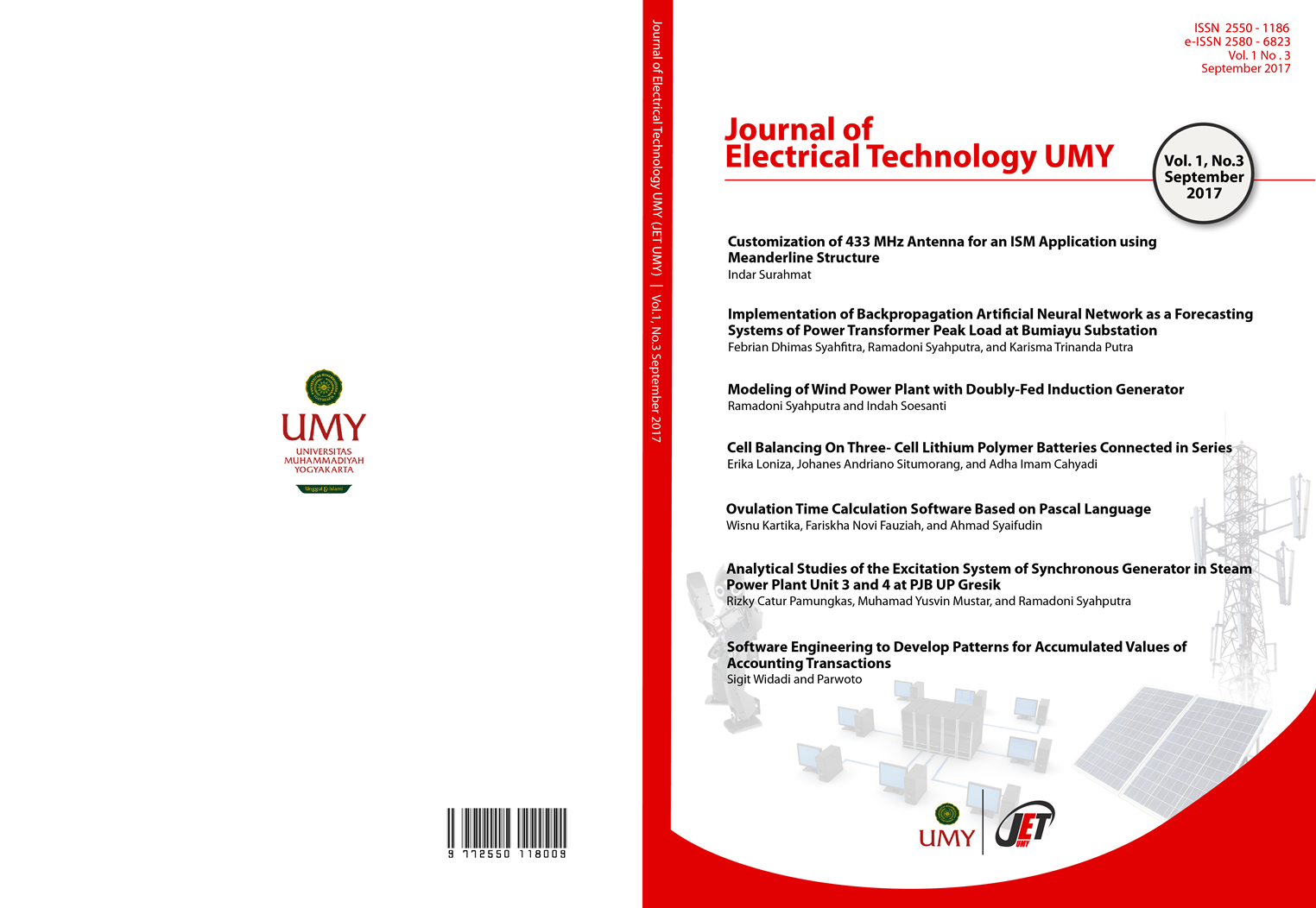Customization of 433 MHz Antenna for an ISM Application using Meanderline Structure
DOI:
https://doi.org/10.18196/jet.1315Keywords:
antenna, ISM, meander line, wireless communicationAbstract
Innovation on ISM devices has been an interensting trend in robotics application. Antenna as a wireless interfacing part in communication between the device and another requires a specific design to fit an available space in the device. This paperexplores a customized design of 433MHz antenna for an application of ISM devices.
Antenna is designed by using meandeline structure theory. An antenna for the frequency has been simulated and fabricated. The design is implemented in 38mm x 110mm FR-4 PCB with thickness 1.6mm. The antenna has a maximum gain 1.1 dB and SWR 1.83 at the frequency.
References
Ryu, H. K., Lim, S., Woo, J. M., 2008. Design of electrically small, folded monopole antenna using Cshaped meander for active 433.92 MHz RFID tag in metallic container application, Electronics Letters, Volume: 44, Issue: 25 Pages: 1445 - 1447.
Wang, X.Y., et.al, 2015. “A Compact 433MHz Antenna with Enhanced Performance by Using Multi-Resonant Meander Line Structure”, AsiaPasific Microwave Conference (APMC), Year: 2015 Volume: 2 Pages: 1 – 3
Loutridis, A., John, M., and Amman, M.J., “Folded Meander Line Antenna for Wireless M-Bus in the VHF and UHF bands”, Electronic Letters, 23rd
July 2015 Vol. 51 No. 15 pp. 1138 - 1140.
Hsu, C.C, Song, H.H, 2013. “Design, Fabrication, and Characterization of a Dual-B and Electrically Small Meander-line Monopole Antenna for Wireless Communications” International Journal of Electromagnetics and Applications.
Wheeler, H.A, 1947. “Fundamental Limitation of Small Antennas”, Proceeding of the IRE, vol. 35, no. 12, pages : 1479 – 1484, 1947
McLean, J.S., 1996. “A Re-examination of Fundamental Limits on the Radiation Q of Electrically Small Antennas”, IEEE Transactions on
Antennas and Propagation, volume 44, no. 5, pages : 672 – 676.
Gionne, G., 1984. “Analytical Formulas for Coplanar Lines in Hybrid and Monolithic MICs”, IEEE Electronics Letters, vol.20, no. 4, pages : 179 –
Hilberg, W., 1969. “From Approximations to Exact Relations for Characteristic Impedances”, IEEE Transactions on Microwave Theory and Techniques, volume 17, no. 5, pages : 259 – 265.
Balanis, C. 1997. “Antenna theory analysis and design” 2nd edition. Wiley, New York.
Downloads
Published
How to Cite
Issue
Section
License
Copyright
The Authors submitting a manuscript do so on the understanding that if accepted for publication, copyright of the article shall be assigned to Journal of Electrical Technology UMY. Copyright encompasses rights to reproduce and deliver the article in all form and media, including reprints, photographs, microfilms, and any other similar reproductions, as well as translations.
Authors should sign Copyright Transfer Agreement when they have approved the final proofs sent by the journal prior the publication. JET UMY strives to ensure that no errors occur in the articles that have been published, both data errors and statements in the article.
JET UMY keep the rights to articles that have been published. Authors are permitted to disseminate published article by sharing the link of JET UMY website. Authors are allowed to use their works for any purposes deemed necessary without written permission from JET UMY with an acknowledgement of initial publication in this journal.
License
All articles published in JET UMY are licensed under a Creative Commons Attribution-ShareAlike 4.0 International (CC BY-SA) license. You are free to:
- Share — copy and redistribute the material in any medium or format
- Adapt — remix, transform, and build upon the material for any purpose, even commercially.
The licensor cannot revoke these freedoms as long as you follow the license terms. Under the following terms:
- Attribution — You must give appropriate credit, provide a link to the license, and indicate if changes were made. You may do so in any reasonable manner, but not in any way that suggests the licensor endorses you or your use.
- ShareAlike — If you remix, transform, or build upon the material, you must distribute your contributions under the same license as the original.
- No additional restrictions — You may not apply legal terms or technological measures that legally restrict others from doing anything the license permits.







